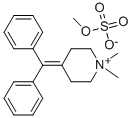
Diphemanil Methylsulfate
- Product NameDiphemanil Methylsulfate
- CAS62-97-5
- CBNumberCB9505795
- MFC20H24N.CH3O4S
- MW389.51
- EINECS200-552-4
- MDL NumberMFCD00865157
- MOL File62-97-5.mol
Chemical Properties
| Melting point | 194-195℃ |
| storage temp. | Inert atmosphere,Store in freezer, under -20°C |
| Water Solubility | Soluble in water |
| solubility | : 16.67 mg/mL (42.80 mM; Need ultrasonic) |
| form | powder to crystal |
| color | White to Almost white |
| Stability | Hygroscopic |
| EWG's Food Scores | 1 |
| FDA UNII | W2ZG23MGYI |
| ATC code | A03AB15 |



